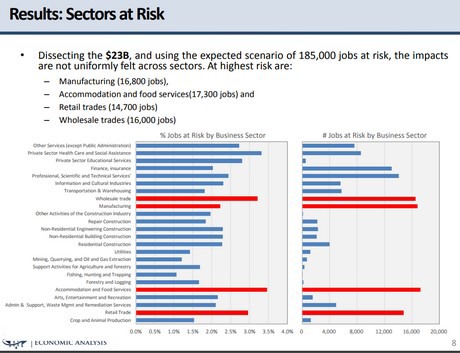Too fast
The minimum wage per hour per worker is set to reach $15 on January 1, 2019 and will be raised in two phases, from the current minimum wage of $11.40 to $11.60 by October 1 and then to $14 by January 1, 2018 - a 23 percent increase in just four months. For this reason, this latter raise is concerning flower farmers the most. "It will not provide sufficient time for Ontario businesses to prepare and plan for the increased cost of production as greenhouse markets and related production is significant in the first quarter. Therefore, planning is a key issue now in defining the structure of work, size of work force, locating the workforce and so on", says Linington.
Increasing overall labor costs
The increase in minimum wage will increase the overall labor costs in a very short time. In a previous press release, FCO President Ian Vermeer points out that history shows that when the bottom of the wage scale goes up the entire scale has to move with it. "As a result this increase in minimum wage will lead to a 30% increase in our labor cost in a very short time. Very few flower growers are capable of absorbing this new cost.”
Informing the government
At this point in time grower groups like FCO are working in harmony with other farm commodity groups in telling this story to government. "Our goal is to either get the time frame relaxed and mirror one of our major competitors (the state of California, USA, which is set to reach a minimum wage of $15 per worker per hour by 2023), and/or some form of financial support/subsidy."
And they will also stress the larger impact of this minimum wage hike beyond the greenhouse industry. "The Ontario Chamber of Commerce, representing a large group of business sectors (accommodation, food processing, food retail, fast food, retail sales, service sectors, and so on), have just released an economic impact study that identifies a number of unintended consequences like less employment, higher inflation, greater youth unemployment, etc."
Link to elections
According to Linington, the increase in minimum wage seems to be motivated by a political party trying to improve their popularity in the polls before an election. "The political party(s) are reflecting a dissatisfaction of society around the loss of middle income jobs, the loss of jobs, loss of job security and the concentration of wealth related to free trade agreements. Newer trade agreements are looking at developing nations establishing international level worker standards. Jurisdictions can easily put their business in a non-competitive position, if their legislation is not competitive with trading partners."
Growers in Alberta and British Columbia also affected
Alberta and British Columbia growers will also need to reckon with the higher cost of production as a result of higher labor costs. Yesterday the provincial government of B.C. announced its first move toward a $15-an-hour minimum wage by announcing a 50-cent increase for September and renewing its commitment to a fair wages commission. Effective Sept. 15, 2017, minimum-wage earners will see their pay increase to $11.35 per hour from $10.85 per hour, giving B.C. the third-highest minimum wage among Canada’s provinces.
In Alberta the general minimum wage will increase from $12.20 per hour to $13.60/hour on October 1. Next year, October 1, 2018, the Alberta minimum wage will further increase to 15$ per hour.
185K job to be lost
• 17% of the expected job losses• About 30,000 jobs at risk or a 3.0% reduction in employment percentage– Over 25yrs to 55yrs represent:• 63% of the expected job losses• About 116,000 jobs at risk or a 2.6% reduction in employment percentage
• 20% of the expected job losses• About 38,000 jobs at risk or a 2.6% reduction in employment percentage
• 52% of the expected job losses are expected to be women• About 96,000 jobs at risk for women (2.8%) and 89,000 jobs at risk for men (2.5%)

For more information
Flowers Canada (Ontario)
Andrew Morse
Executive Director
519-836-5495
www.flowerscanadagrowers.com










